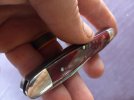- Joined
- Apr 12, 2014
- Messages
- 801
I recently found this Case 6279 in an old tool box of my father in laws. Can someone help me determine the scale material? I've found several jigged red bone examples but not any with smooth covers like this. Did they make a smooth red bone? The dots are mostly hidden under the bolster but it looks to me to be a 10 dot, so 1970? Can. Anyone more knowledgeable confirm? Thanks for looking.
6279 https://imgur.com/gallery/IMTSPLh
6279 https://imgur.com/gallery/IMTSPLh





